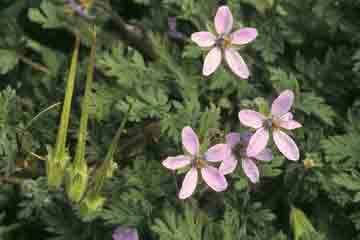
Crane’s bill, Erodium cicutarium L’Hér. ex Aiton (right). The crane’s bill (also stork’s bill, and filaree) is a small, pink-flowered Eurasian plant that has spread worldwide. In early spring the plants appear, often in great numbers, and are still blooming well into the fall.. Although considered a weed, the erodium is an excellent browse plant. It grows as high as the montane zone, although less common there than at lower elevations. Crane’s bills are creeping plants, usually only an inch or so high. Their long, persistent styles explains the erodium’s scientific and common names (Erodium from the Greek means “crane” or “heron”). The species name, cicutarium implies that its leaves resemble those of the Cicuta, the European water hemlock.
